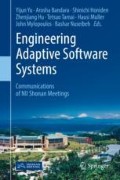Abstract
The chapter focuses on experimentation with adaptation in the field of smart cyber-physical systems (sCPS). In particular, it provides a model problem that features a coordination of autonomous cleaning robots. The model problem is accompanied with a testbed which allows the execution of the model problem along with custom adaptation logic. The testbed can be executed as a simulation of multiple robots running or deployed on an actual TurtleBot robot. Both the simulated and actual deployment environment are based on the same software stack. The offered simulation is precise timing-, bandwidth-, and mobility-aware and brings together a ROS-based Stage simulation of a swarm of robots and OMNeT++-based simulation of 802.15.4 wireless network, while the actual deployment is based on the TurtleBot robotic platform. The adaptation business logic is based on the DEECo component model and points to specific places, where the user code can be easily plugged in.
Access this chapter
Tax calculation will be finalised at checkout
Purchases are for personal use only
Notes
- 1.
It is based on material included in a SEAMS 2016 publication by the same authors [5].
- 2.
- 3.
- 4.
- 5.
- 6.
- 7.
- 8.
- 9.
- 10.
- 11.
- 12.
- 13.
- 14.
- 15.
- 16.
- 17.
- 18.
- 19.
- 20.
References
Blackburn, S.M., Garner, R., Hoffmann, C., Khang, A.M., McKinley, K.S., Bentzur, R., Diwan, A., Feinberg, D., Frampton, D., Guyer, S.Z., Hirzel, M., Hosking, A., Jump, M., Lee, H., Moss, J.E.B., Phansalkar, A., Stefanović, D., VanDrunen, T., von Dincklage, D., Wiedermann, B.: The dacapo benchmarks: java benchmarking development and analysis. SIGPLAN Not. 41(10), 169–190 (2006). https://doi.org/10.1145/1167515.1167488
Bures, T., Gerostathopoulos, I., Hnetynka, P., Keznikl, J., Kit, M., Plasil, F.: Deeco: an ensemble-based component system. In: Proceedings of the 16th International ACM Sigsoft Symposium on Component-Based Software Engineering, CBSE’13, pp. 81–90. ACM, New York (2013). https://doi.org/10.1145/2465449.2465462
Cheng, S.W., Schmerl, B.: Znn model problem. http://self-adaptive.org/exemplars/model-problem-znn-com. Accessed 22 Jan 2016
Kim, K., Kumar, P.R.: Cyber-physical systems: a perspective at the centennial. Proc. IEEE 100(Centennial-Issue), 1287–1308 (2012). https://doi.org/10.1109/JPROC.2012.2189792
Matena, V., Bures, T., Gerostathopoulos, I., Hnetynka, P.: Model problem and testbed for experiments with adaptation in smart cyber-physical systems. In: Proceedings of the 11th International Symposium on Software Engineering for Adaptive and Self-Managing Systems, SEAMS’16, pp. 82–88. ACM, New York (2016). https://doi.org/10.1145/2897053.2897065
NIST: Cyber physical systems: situation analysis of current trends, technologies, and challenges. In: NIST CPS Workshop (2012). http://events.energetics.com/NIST-CPSWorkshop/pdfs/CPS_Situation_Analysis.pdf
Salehie, M., Tahvildari, L.: Self-adaptive software: landscape and research challenges. ACM Trans. Auton. Adapt. Syst. 4(2), 14:1–14:42 (2009). https://doi.org/10.1145/1516533.1516538
Self-adaptive systems community repository. http://self-adaptive.org/exemplars. Accessed 22 Jan 2016
Sha, L., Gopalakrishnan, S., Liu, X., Wang, Q.: Cyber-physical systems: a new frontier. In: Singhal, M., Serugendo, G.D.M., Tsai, J.J.P., Lee, W., Römer, K., Tseng, Y., Hsiao, H.C.W. (eds.) IEEE International Conference on Sensor Networks, Ubiquitous, and Trustworthy Computing (SUTC 2008), Taichung, 11–13 June 2008, pp. 1–9. IEEE Computer Society (2008). https://doi.org/10.1109/SUTC.2008.85
Shtern, M., Smit, M., Simmons, B., Litoiu, M.: A runtime cloud efficiency software quality metric. In: Companion Proceedings of the 36th International Conference on Software Engineering, ICSE Companion 2014, pp. 416–419. ACM, New York (2014). https://doi.org/10.1145/2591062.2591127
Spec benchmarks. http://www.spec.org/benchmarks.html. Accessed 22 Jan 2016
Weyns, D., Calinescu, R.: Tele assistance: a self-adaptive service-based system examplar. In: Proceedings of the 10th International Symposium on Software Engineering for Adaptive and Self-Managing Systems, SEAMS’15, pp. 88–92. IEEE Press, Piscataway (2015). http://dl.acm.org/citation.cfm?id=2821357.2821373
Weyns, D., Malek, S., Andersson, J.: Forms: a formal reference model for self-adaptation. In: Proceedings of the 7th International Conference on Autonomic Computing, ICAC’10, pp. 205–214. ACM, New York (2010). https://doi.org/10.1145/1809049.1809078
Wuttke, J., Brun, Y., Gorla, A., Ramaswamy, J.: Traffic routing for evaluating self-adaptation. In: Müller, H.A., Baresi, L. (eds.) 7th International Symposium on Software Engineering for Adaptive and Self-Managing Systems, SEAMS, Zurich, 4–5 June 2012, pp. 27–32. IEEE Computer Society (2012). https://doi.org/10.1109/SEAMS.2012.6224388
Acknowledgements
The work on this paper has been partially supported by the Charles University Grant Agency project No. 391115 and Charles University institutional funding SVV-2016-260331. This work is part of the TUM Living Lab Connected Mobility (TUM LLCM) project and has been funded by the Bayerisches Staatsministerium für Wirtschaft und Medien, Energie und Technologie (StMWi).
Author information
Authors and Affiliations
Corresponding author
Editor information
Editors and Affiliations
Rights and permissions
Copyright information
© 2019 Springer Nature Singapore Pte Ltd.
About this chapter
Cite this chapter
Matena, V., Bures, T., Gerostathopoulos, I., Hnetynka, P. (2019). Experimenting with Adaptation in Smart Cyber-Physical Systems: A Model Problem and Testbed. In: Yu, Y., et al. Engineering Adaptive Software Systems. Springer, Singapore. https://doi.org/10.1007/978-981-13-2185-6_7
Download citation
DOI: https://doi.org/10.1007/978-981-13-2185-6_7
Published:
Publisher Name: Springer, Singapore
Print ISBN: 978-981-13-2184-9
Online ISBN: 978-981-13-2185-6
eBook Packages: Computer ScienceComputer Science (R0)

